Granada is one of Spain’s most beautiful and fascinating cities. There is sooo much interesting history here, and spending 2 days in Granada will help you experience the best of what the city has to offer.
I grew up in a city called Alhambra, a suburb of Los Angeles. Our high school mascot was the Moors. I never really knew much about the significance of the namesake Alhambra palace in Granada, and only vaguely knew of the Moors as some sort of “Spanish warriors” (not really accurate). When I had the chance to spend a weekend in Granada, I jumped at it and relished the chance to learn more about both the Alhambra and the Moors.
And boy, what a fascinating city! There is so much history in Granada, and it was such an incredible experience to see it come alive in front of my eyes. I learned so much about Spanish history during my 10 days in Spain.
Granada plays such a significant role in Spain’s history, and after visiting the other major cities in the Andalusia region (2 days in Seville and then a day in Cordoba), it was like finding the missing piece of a puzzle. You *have* to visit the city for the rest of it to make sense, and this 2 day Granada itinerary will help you do that.
Not only that, the city is truly gorgeous and enchanting, full of charming streets, picturesque landmarks, and spectacular views. Did I also mention that there’s free tapas (more on that later) 😉 ?
Granada will draw you in and make you fall in love – guaranteed! Keep on reading to find out how to see the best of Granada in 2 days!
**This post contains affiliate links. This means that if you make a purchase or booking, I may receive a small commission at no additional cost to you. Pictures & Words is a participant in the Amazon Services LLC Associates Program, an affiliate advertising program designed to provide a means for us to earn fees by linking to amazon.com and affiliated sites at no cost to you.
Things to Know Before Your 2 Days in Granada Itinerary

How many days in Granada – is 2 days enough?
While many people visit Granada only on a day trip to visit the Alhambra, I *HIGHLY* recommend spending two days there.
Some may feel that there isn’t much to do in Granada aside from seeing the famous Alhambra Palace. This couldn’t be farther from the truth! There is so much more to the city than the Alhambra, and a 2 day Granada itinerary will allow you to experience it more fully.
If you can only spare a day in Granada, then you can see many of the city’s highlights on a super rushed itinerary. However, it is recommended to spend 2 days in Granada in order to devote an ample amount of time to the Alhambra and all of the city’s other attractions.
You’ll get a feel for the city and see a lot in Granada in 2 days. You’ll get to visit the sights in the historic center, as well as explore the fascinating neighborhoods of Albaicin and Sacromonte. In addition, you can fully take advantage of the tapas scene in Granada – which offers FREE tapas with every drink purchase (yes, you read that right!). If that isn’t a good reason to spend two days in Granada, then I don’t know what is!
I thought two days was a good amount of time to experience the city and didn’t think that any additional time was necessary. However, if you prefer to explore the city at a super relaxed pace, then you may consider adding an extra day to your Granada itinerary.

When to visit Granada
Granada is located in the Andalusia region of southern Spain, synonymous with its plentiful sunny days and year-round warm weather. However, do know that Andalusia does experience hot summers!
Here’s what to expect when spending a weekend in Granada at different times of the year:
Summer
The summer months are considered to be Spain’s high season, and therefore Granada’s as well. June through early September are the most popular times to visit, and therefore accommodation prices and crowds will be at their highest.
Personally, I would avoid the summer months to spend 2 days in Granada, as not only does it get busy, it gets SUPER hot. The highs in the summers often reach 40 degrees Celsius – that’s over 100 degrees Fahrenheit – so that’s HOT!
If you do decide to visit in the summer, it is vital that you book your tickets for the most popular attractions, especially the Alhambra, way in advance to avoid any disappointments! It is also recommended to book your accommodations and any flights/train tickets in advance.


Spring/Fall (Shoulder Season)
The spring (March-May) and fall (mid-September to November) months are considered Granada’s shoulder season, and the best time to visit. You’ll still get warm (but not blistering hot) weather and much fewer crowds!
We visited in October and felt that it was the perfect time to go! The temperatures were super comfortable, and the city didn’t feel crowded at all. It was kinda overcast, but it was still beautiful!
You’ll still want to book tickets to the most popular attractions – specifically the Alhambra – in advance! Tickets to the Nasrid Palace sold out more than two weeks before our visit.
Winter
The winter months are considered to be Granada’s low season, but it is not a bad time to visit – especially if you want to escape crowds.
While crowds do thin out considerably during the winter months, it is still important to book tickets for the Alhambra in advance.
Average highs in December, January, and February are usually in the 50s Fahrenheit. However, the temperatures do drop near freezing at night, so be sure to pack warm layers if visiting during these months!
If you are a winter sports enthusiast, winter is a perfect time to visit Granada, as there are ski resorts located just 30 minutes away, in the surrounding Sierra Nevada mountains.

Getting to Granada
As one of Andalusia’s top destinations and home to one of the most visited tourist attractions in Spain, Granada is a relatively well-connected city. You can easily get to and from Granada from many major cities in Spain and across Europe.
Via Air
If traveling to Granada by plane, the city has its own airport, Federico Garcia Lorca Granada-Jaen Airport (GRX), located 18 kilometers (~11 miles) from the city center.
The airport serves mainly domestic and European flights, with airlines such as Ryanair, Vueling, and EasyJet regularly flying in and out of Granada.
The cheapest way to get from the airport to the city center is by airport bus, operated by Alsa. There are around 10 departures a day (here is the timetable, with the complete schedule), and the fare is €4. The trip takes about 45 minutes.
You can also take a taxi to the city center, which takes about 25 minutes. The fare averages around €35, but can be higher depending on traffic, and on weekends and evenings.
Do note that flights into the Granada airport tend to be limited. Another option is to look into flights that arrive to Malaga (AGP), located 90 minutes away, which is a larger airport with more options. From Malaga, you can take a high-speed train to get to Granada.


Via Train
We mostly got around by train during our time in Spain, and I highly recommend it! The high-speed trains in Spain are relatively efficient and comfortable, making it a fantastic way to travel around the country – and especially around the Andalusia region.
While at first glance, it might seem like it might take more time, by the time you factor in the time it takes getting to/from the airport, going through security, waiting at the gate, and getting to/from your accommodations, it isn’t that much more. Plus, it’s a whole lot more comfortable and you get to see the Spanish countryside!
Spain’s rail system is operated by Renfe, which includes both regional and high-speed AVE trains. While the AVE trains are a bit more expensive, I recommend taking them as they will save you a bit of time!
Renfe’s site is notoriously difficult to figure out, especially if you don’t speak Spanish and/or are using a foreign credit card. To save you time and hassle, I highly recommend booking your train tickets through Omio, which streamlines the booking process.


It was so easy to book our tickets through the app, and it was so convenient to have all our tickets saved in one place. You’ll pay a few extra Euros for the convenience, but trust me, it was soooo worth it to save the headache & hassle of trying to figure out the Renfe site (and having your credit card rejected a bunch of times).
Do note that similar to many high-speed rail systems in Europe, AVE trains rely on a dynamic pricing model. This means that you should book your train tickets as soon as possible, as they tend to shoot up in price the closer you get to your departure date. When we first started planning our trip, the fare was €60 back to Barcelona, but since we procrastinated and waited until the last minute, we ended up paying almost €100 by the time we actually went to book. So, basically – don’t be us!
Here are some of the travel times from major Spanish cities to Granada:
- Seville: 2.5 hours
- Malaga: 1 hour, 15 minutes
- Cordoba: 1 hour, 45 minutes
- Madrid: 3 hours, 45 minutes
- Barcelona: 6 hours
Granada’s train station is located 3 kilometers from the city center – from here, you can easily take a taxi or hop on a bus to get to your accommodations.


Via Bus
Traveling to Granada by bus is also another option. Bus service to and from Granada is offered by several companies, including FlixBus and Alsa.
Buses arrive to Granada’s bus station, located about 3.5 kilometers north of the city center. From here, you can connect to your accommodations via taxi or bus.
Driving
Granada is a popular stop on a road trip through southern Spain.
I recommend renting a vehicle through rentalcars.com, which allows you to compare prices and find deals from many of the major car rental agencies. They also have flexible cancellation policies and offer a price match guarantee.
However, you don’t actually need a car while in the city itself for your Granada 2 day itinerary. Driving can be a challenge, since the historic center is made up of a bunch of narrow streets. If you are planning to drive around the region, plan on picking up your car as you leave Granada, or find a hotel with parking and leave the car there.
Getting around during your 2 day Granada itinerary

Walking
Granada is a VERY walkable city. Most of its top attractions are located in the historic center, Albaicin, or Sacromonte, which are all easily accessible on foot. In fact, I got around during my entire Granada 2 day itinerary on foot!
Granada is full of insanely charming streets and narrow cobblestone alleys are just made for walking. I personally think that the best way to take in the city’s beauty is by walking its streets!
Be sure to wear comfortable shoes though – leave the high heels and wedges at home. My go-to travel shoes are sneakers from Allbirds, flats from Rothy’s, and sandals from Crocs.
Do note that the city can be pretty hilly and some attractions can require a hike to reach (particularly the Alhambra), so be prepared for a workout (it kinda reminded me of Porto and Sintra a bit in that sense)!


Public transportation
So what do you do when your feet are tired or if you don’t want to climb up those hills?
Granada is made up of narrow, hilly streets, so you won’t see many traditional buses running in the main tourist areas. Instead, it has a network of mini buses that stop at the top sights in the historic center, Albaicin, Sacramonte, and the Alhambra.
A one-way ride costs €1.40, but if you plan to use them at least 5 times, there are travel cards which will offer you a discount as well. Here’s more about the routes and fares.
Taxis
While Granada doesn’t have any ride sharing services such as Uber or Lyft, there are plenty of traditional taxi cabs available. You can hail a cab on the street, or from a taxi stand. However, if you plan to use taxis during your weekend in Granada, I recommend downloading Cabify or FreeNow apps which work similarly to Uber but for traditional taxis.
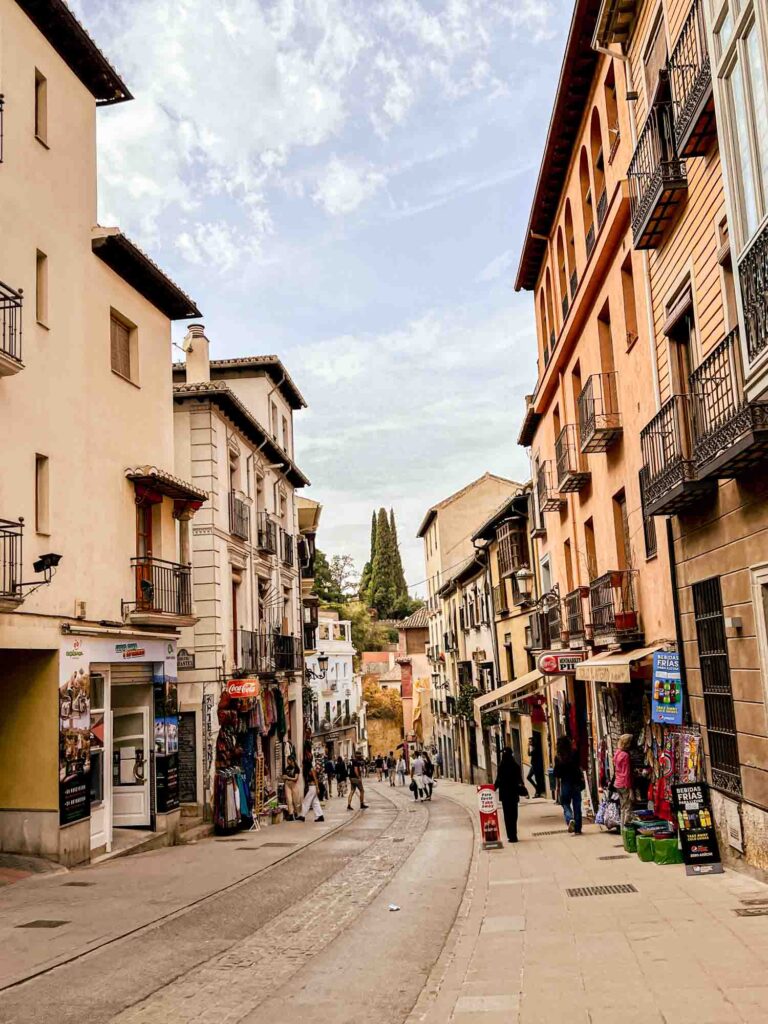
Language in Granada
The official language of Spain is Spanish.
While traveling through the Granada and Andalusia region, I found it VERY helpful to have knowledge of some basic Spanish. While there is some English spoken in the main tourist areas, I found that it was limited compared to other cities such as Barcelona, and found myself mostly speaking Spanish (however pitiful it may be).
I suggest brushing up on some Spanish on Duolingo before your two days in Granada! Also be sure to download Google Translate to help you out.


Currency/Money
As with many countries in Europe, Spain’s official currency is the Euro.
While I found that most establishments accepted credit cards, I found it helpful to have a little bit of cash on hand for small transactions and for the few places that didn’t.
I recommend withdrawing cash at an ATM over a currency exchange counter, as the rates are much more favorable. I withdrew some cash at an ATM upon landing at the Barcelona Airport, so I don’t have to worry about it later. However, you can find ATMs all around Granada if you need them.
Tipping is not customary in Spain, although some establishments may add a service charge. You can leave 10% or a few Euro coins for exceptional service, but it is not expected.

What to pack for your 2 days in Granada
- Comfortable shoes: You’ll likely be doing a LOT of walking during your 2 days in Granada, so pack some comfy shoes! Also note that there’s lots of cobblestone streets, so leave the heels at home. I LOVE my Allbirds sneakers (like walking on clouds!) and flats (so cute AND comfy), as well as these Crocs sandals which are comfy and super stylish, I swear!
- Power adapter: Spain (and the rest of Europe) use 230 V Type E plugs, so you’ll need a power adapter if you’re coming from the United States.
- Power bank: Keep all of your devices charged as you explore Granada in 2 days – all that navigating and taking photos can drain your battery super quick!
- Reusable water bottle: Free tap water isn’t really a thing in Spain (or in Europe for that matter), and you’ll have to pay for bottled water in restaurants! Save your money for sangria and carry your own water with you so you can stay hydrated. I usually buy a giant bottle at a store and then fill up my bottle each day.
- Sunscreen: The sun gets pretty intense in this part of Spain, so don’t forget the SPF! Also, here’s my favorite face sunscreen (and a top off)


A few more things to know before your weekend in Granada…
- Buy tickets for the Alhambra in advance: I know I’ve mentioned this a few times already (and I’ll probably mention it again later in this 2 day Granada itinerary), but this is an absolute MUST. Book Alhambra tickets as soon as you know you’re going to Granada in order to avoid disappointment.
- Dinner is late: Most people in Spain eat dinner around 8 or 9pm. Many places don’t even open for dinner until 8pm! For those that are open earlier, it worked out in our favor since we were still eating at our normal dinner hour (around 7pm), and it wasn’t yet busy.
- Tapas are usually free: Most restaurants will give you a free tapa upon ordering a beverage (yes, even a nonalcoholic one). You won’t be able to choose the tapa you want in most cases (although some spots let you!), but it’s a fun way to try out all the different tapas in the city, and for cheap.
- Air quality is bad: My boyfriend and I both got terrible allergies here and wondered why until our Alhambra tour guide told us that Granada has some of the worst air quality in Spain. This is because it is located in between the ocean and the Sierra Nevada mountains, and sand and debris get trapped here. In fact, while we were here, there was dust and sand that blew in from the Sahara Desert! If you are sensitive, come prepared with allergy meds, or an inhaler if you have asthma.
- Watch out for scams: Granada is generally considered to be a very safe city, but scams are common. In particular, watch out for the rosemary scam in Granada, where a woman will give you a small sprig of rosemary and offer to read your fortune. She will then demand money for her services – and sometimes an accomplice will take your stuff while you’re distracted.

Where to stay in Granada
I *highly* recommend that you stay within the historic center, specifically within a 5-10 minute walk of Plaza Nueva. This will put you close to all the top sights and make it much more efficient as you explore Granada in 2 days.
Some people recommend staying in Albaicin, as it is super picturesque and charming, but I disagree as it is VERY hilly, and you’ll be a bit further away from everything. Granada may be compact, but you don’t want to waste any time!
Here are some recommended places to stay in Granada:
- Room Mate Leo: This is where we stayed during our weekend in Granada, and I enjoyed the recently renovated rooms with rich decor inspired by the Alhambra. There’s also a rooftop terrace with a view of the Alhambra! It’s also located in the heart of the historic center and getting around was a breeze. However, I would avoid staying here on the weekends as you can hear all the noise from the streets and it stays noisy well into the middle of the night.
- Hotel Casa 1800: This boutique hotel is BEAUTIFUL and staying here will make you feel like royalty! The decor features some ornate elements such as a canopy bed and crystal chandeliers. There’s a pretty courtyard as well. The location is right in between the historic center and Albaicin, which makes it super convenient to get to both.
- Gar Anat Hotel Boutique: This cozy property plays off Granada’s architectural spirit, with brightly decorated rooms, along with a courtyard inspired by the Alhambra. You can’t beat the locations, just a short walk to many of the top sights. The rates are pretty affordable as well.
How to See Granada in 2 Days: The Perfect Itinerary
Granada Itinerary DAY 1 (Historic Center + Albaicin)

Granada Cathedral (Catedral de Granada)
The Granada Cathedral is one of the most significant landmarks in the city’s historic center, showing the convergence of its Christian and Muslim history.
Established on the site of where the Grand Mosque once stood, the Cathedral was built as a symbol of the transfer of power to Christian rule. Construction began in 1518 and took nearly 200 years for completion.
It was originally modeled after the Cathedral of Toledo, but multiple architects were involved in the project. As a result, you can see a unique mix of Gothic and Renaissance styles, and it also has a Baroque facade.
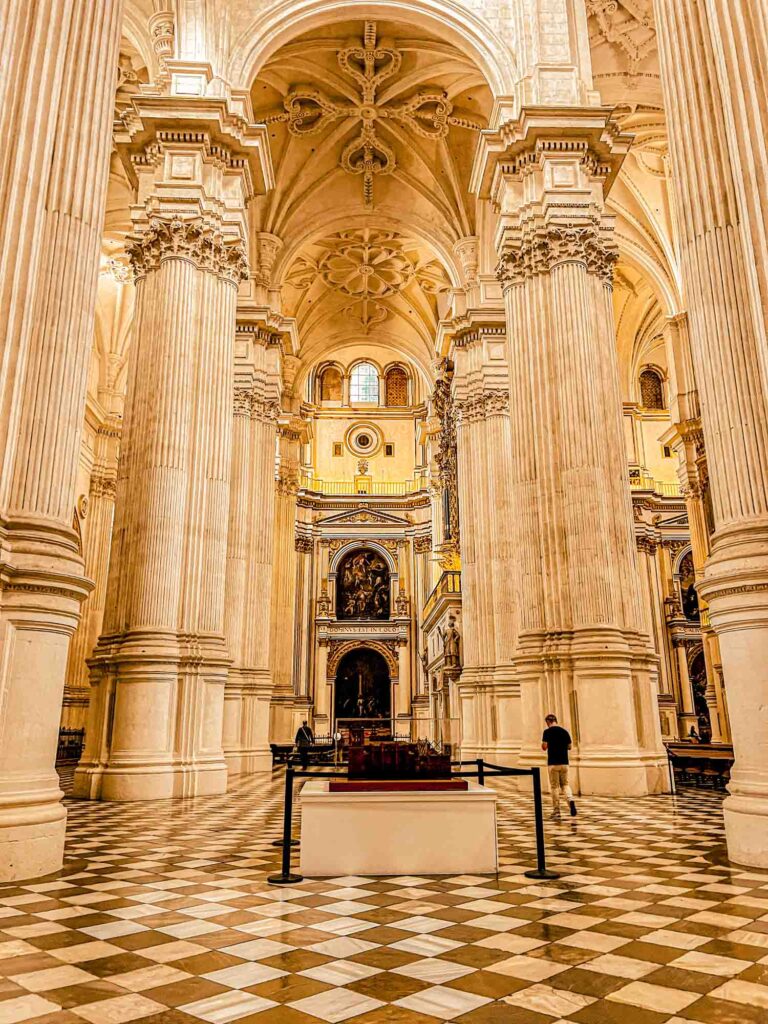

To be honest, I almost skipped the Granada Cathedral because I was a bit churched out after already spending a week in Spain, and initially thought “it’s just another church.” However, a tour guide convinced me to visit for its white marble interior, and I was glad I did – it was pretty impressive! The altar and cupola are stunning as well.
It costs €5 to visit the Cathedral.

Royal Chapel (Capilla Real)
Located directly across from the Granada Cathedral, the Royal Chapel is best known for the final resting place of Ferdinand II of Aragon and Isabella I of Castile, arguably Spain’s most famous monarchs. Their children, Joana and Phillip, are also buried here.
Let’s talk about Ferdinand and Isabella for a bit. They are perhaps some of the most polarizing figures in Spanish history, but there’s no denying that they played an important part in it.
Ferdinand and Isabella were the first Catholic monarchs of Spain and ruled over the country during the Reconquista period, when Spain regained control of the areas ruled by the Moors. During this time, Spain’s Muslim and Jewish population living in Granada (and Andalusia as a whole) were forced to convert to Christianity, or face exile.
Spain also experienced a period of economic growth under the rule of Ferdinand and Isabella, getting out of debt and fueling massive explorations around the globe, led by Christopher Columbus and other explorers. This brought Spain to rule much of the Americas as well and unfortunately, this did not end well for the indigenous populations in the territories they conquered.
Still, you can’t deny the significant role that Ferdinand and Isabella played in shaping Spanish history, and the Royal Chapel is one of Granada’s most important historical sites that is well worth visiting. It is an interesting and beautiful place to visit, and will help you piece together the parts of Granada’s history. It’s definitely a worthwhile stop, even when you are trying to see Granada in 2 days.
Do note that there are no photos allowed inside the Royal Chapel. The entrance fee is €5. Also note that the Royal Chapel may be closed for services.


Alcaicería
A series of narrow streets near the Cathedral, the Alcaicería is located where the Moorish silk market or Grand Bazaar once was. It dates back to the 15th century, but was almost destroyed in a fire in the 1800s. While the Alcaicería still remains, there is only one street left.
The Alcaicería stretches from Plaza Alonso Cano to Calle Ermita, near the Cathedral. You’ll find the street lined with tons of vendors selling everything from Middle Eastern-themed goods, textiles, scarves, Spanish tiles, postcards, clothing, spices, and much more.
Admittedly, it is a bit touristy; however, it does still have a distinctive Moorish feel. It’s a great spot to do some souvenir shopping – or just wander through on your Granada 2 day itinerary.

Plaza Nueva
Plaza Nueva is the main square in Granada, as well as its oldest. Chances are that if you’ve signed up for any guided tours during your two days in Granada, the meeting point is at Plaza Nueva.
Originally built to create space over the Darro River, it separates the historic center from Carrera del Darro, which leads up to the Albaicín district (which will be your next stop on this 2 day Granada itinerary).
It’s usually a flurry of activity in Plaza Nueva, and it’s a fantastic place to do some people-watching. I also really loved the mix of colorful buildings that surround the square, as well as the view of the Alhambra perched right up on the hill.

Albaicín
Once the Arab Quarter of Granada, the Albaicín district (also known as Albayzin, its Muslim spelling) is one of the city’s most charming and picturesque areas and a must on your Granada 2 day itinerary. Designated a UNESCO World Heritage site, you’ll find a maze of narrow cobblestoned streets here, with whitewashed buildings and Moorish architecture.
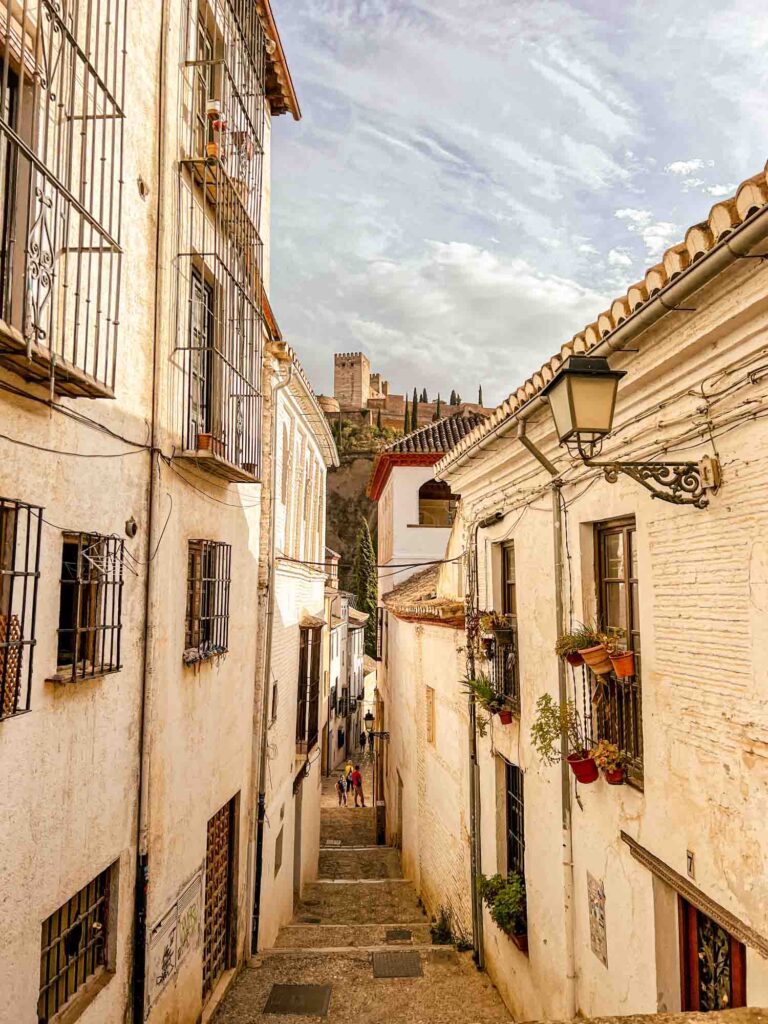


At its height during the dominance of Moorish rule, over 40,000 people lived in the neighborhood, which was also home to 30 mosques. Sadly, none of the mosques remain today – they were demolished to build churches – and many of the Muslims fled. Their houses and belongings were used by Christians to build their fortunes, and fund the Spanish explorations.
While you can explore the Albaicín on your own and wander through the streets (you can easily spend hours getting lost in the streets!), I highly recommend taking a walking tour of the area to get a bit more context as there is so much interesting history here. The buildings in the neighborhood may also look indistinguishable from each other, so this will also allow you to seek out the most significant landmarks.


Carrera del Darro
I recommend starting your explorations of the Albaicín on Carrera del Darro, which leads up to the neighborhood from Plaza Nueva. The street follows the left bank of the Darro River and is one of the most picturesque streets in the city, and home to some of Granada’s oldest buildings.
You’ll can also catch some beautiful views of the Alhambra from Carrera del Darro!

El Bañuelo
Dating back to the 11th century, El Bañuelo (also known as Aammim Alyawza or Baños del Nogal) is one of the best preserved Muslim baths in Spain.
While many of the Muslim landmarks were destroyed in the Albaicín, El Bañuelo survived as it is a bit hidden thanks to a house that was built on top of this. In fact, you’ll walk through the residence as you get to the baths.
Designated a National Monument, El Bañuelo is built with stone and features impressive porticos and arches. It also has a distinctive ceiling with star-shaped cutouts, designed to let in light to the space.
It costs €5 to visit El Bañuelo, however, I visited on a Sunday and happily discovered that admission is free on Sundays (also at a few other monuments as well).

Palacio de Dar Al-Horra
Situated on the top part of the Albaicín, the Palacio de Dar Al-Horra is the only remaining Moorish palace still standing in the district. Along with the Alhambra, it is one of the finest examples of Moorish architecture in the city and is well worth a visit even when seeing Granada in 2 days.
Built in the 15th century, it was once home of the ruling family until it was eventually moved to the Alhambra under a new ruling family.
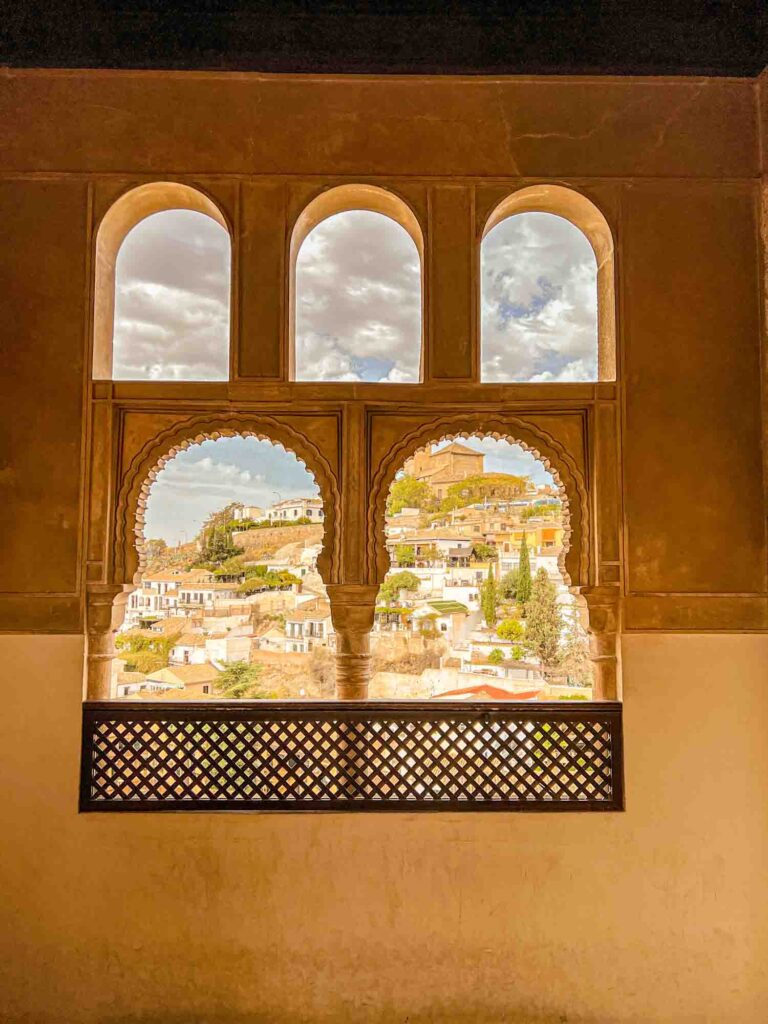
Similar to other construction from Nasrid times, the Palacio de Dar Al-Horra is built around a central garden. The eastern and western sides have a number of rooms, and the rest of the palace features porticos.
It really is one of the most beautiful sights in the city! Do not miss the views of the Albaicín from here, they were some of my favorites in the city.

Mirador de San Nicolas
Mirador de San Nicolas *THE* most popular viewpoint in Granada. One peek at the view and you’ll see why – boasts arguably the best view of the Alhambra, as it is situated directly across from the palace. Checking out the view from here is the perfect way to end the first day of your 2 days in Granada itinerary!
Come at sunset if you can, as it is especially stunning – Bill Clinton even declared it to be the “best sunset in the world.” Sadly, it was a bit overcast and I didn’t get to see much of a sunset, but the view was still stunning!
However, due to its popularity, expect massive crowds at all times of the day. You might have to fight some selfie stick-wielding tourists for a prime viewing spot, but it’s absolutely worth it, I swear!
If you prefer to avoid dealing with the crowds, Mirador de la Vereda de Enmedio is another option for a spot with an amazing view.


Dinner at Restaurante Palacio Andaluz Almona
You can still see the Moorish influence in Granada today, and you can see this in the city’s cuisine. You’ll find some fantastic Middle Eastern restaurants in the city!
We ended the first day of our Granada 2 day itinerary at Restaurante Palacio Andaluz Almona with some incredible Moroccan food! I cannot sat enough about this spot – everything is so flavorful and delicious. Try some authentic tagine and couscous here, and wash it down with some mint tea!
Granada itinerary DAY 2 (Alhambra + Sacromonte)

The Alhambra
Does the Alhambra really need any introduction? Chances are you are spending a weekend in Granada simply because you wanted to see the iconic palace.
You aren’t alone – over 2 million people come to Granada to see the Alhambra each year. It’s one of the most visited attractions in Spain, alternating with the Sagrada Familia in Barcelona for the #1 and 2 spot, depending on the year.
And, the hype is real! It’s famous for a reason, and it will not disappoint. It was truly a highlight during my 2 day Granada itinerary. It is not only gorgeous, with multiple courtyards, gardens, palaces, but is steeped in so much history and it was so fascinating to see it come alive in front of me.
The Alhambra is perhaps the most important piece of architecture from the Moorish times in Andalusia. It was originally built by the Muslims in the 9th century, taken over by Ferdinand and Isabella when they conquered Granada in the 15th century, partially demolished by Charles V in the 16th century, then abandoned in the 18th century.



Perched on top of the hill, the Alhambra complex was once a self-sustaining city, separate from the rest of Granada. It was initially built as a fortress, thanks to its strategic location overlooking the Darro River and the city of Granada. In fact, the name “Alhambra” is named after “al-qal’a al-hamra,” Arab for “the red fortress.”
Eventually, the Nasrid rulers established residence here and started building the palaces that the Alhambra is famous for.
Because the Alhambra is such a popular attraction, it will take a little bit of planning to make sure you can visit. You can’t just show up the day of and expect to be able to buy a ticket! Here are some things to know about visiting the Alhambra –


Buy your tickets in advance!!!!!
I’ve said this several times throughout this Granada 2 day itinerary, and I cannot emphasize this enough!!!! (Have I used enough exclamation points to prove my point lol.) This is one of THE most popular attractions in Spain, and capacity is capped at 6000 people a day. That means, there’s going to be more people who want to visit than there are tickets, especially during the more crowded months.
Book your tickets (you can do it here) as soon as you know you’re going to spend two days in Granada – especially if you plan on visiting the Nasrid Palaces! Tickets go on sale 3 months in advance, and I suggest you get them at least a month in advance – I’d say even 2 months during high season.

The Alhambra is split into 3 sections
- Alcazaba: The fortified military complex and one of the oldest parts of the Alhambra.
- Generalife: The summer palace, which also has some beautiful gardens.
- Nasrid Palaces: What you probably think of when you think of the Alhambra – the ornamental, extravagant palaces.
There are multiple ticket options to visit the Alhambra, and they designate which parts of the complex you have access to. To have the most well-rounded visit, be sure to purchase the Alhambra General ticket, which includes access to all 3 of the areas mentioned above. This option costs €14.
Do note that this ticket option includes timed entry into the Nasrid Palaces, and it is absolutely imperative that you show up on time for your visit – they will turn you away if you are late! You can explore the rest of the grounds freely after you visit the Nasrid Palace.


What if the General tickets are sold out?
If the General ticket is sold out or if you’re on a tight budget, you can also buy a ticket that includes access to the Gardens, Generalife, and Alcazaba ticket for €7.
Unfortunately, the General ticket was sold out for our visit (2.5 weeks ahead of our visit, even in October), and I booked the wrong guided tour. Even though we didn’t get access to the Nasrid Palace, I still thought it was well worth it to see the Gneralife, Alcazaba, and gardens as they were fascinating as well as gorgeous.
I do recommend booking a guided tour in this case, though, as you will get so much more out of your visit and learn soooo much about the history of Granada and the Alhambra’s role in shaping Spain’s history. Here is the tour we did – I highly recommend it!
You can also look to see if there are also guided tours still available that include access to the Nasrid Palaces, although these tend to go pretty quick as well.
Which brings us to…



Consider booking a guided tour
This will give you so much context for your visit, and you’ll learn a ton about the details of the palace, the history of Granada, and the Alhambra’s role in Spanish history. There are so many interesting parts of the complex that I would have overlooked if I had not taken a guided tour. Our guide was super enthusiastic and had a masters degree in Arab studies, with an emphasis on the history of the Alhambra, and she had so many stories and insights to share!
Many tours also include skip-the-line access, which will save you time from waiting in long queues!
If you have your heart set on visiting the Nasrid Palaces and are considering taking a tour, make sure that the tour actually includes access to the palaces. Read the description and make sure that it actually includes the Nasrid Palaces, even when the tour name mentions palaces.
I neglected to do this and accidentally booked a tour that did not include the Nasrid Palaces. I still had an amazing experience, but it was definitely disappointing when I initially realized my mistake!
Here are some highly rated tours that include the Nasrid Palaces:
- Alhambra Skip-the-Line Tour with Nasrid Palaces: This tour includes access to the Nasrid Palaces, Generalife, Alcazaba, and gardens with skip-the-line privileges. You’ll also get to choose your group size, based on your preferences – 10, 20, or 30 participants.
- Alhambra Fast-Track Tour with Nasrid Palaces: This is a wonderful option for those looking for a small group tour, and offers a more personalized experience.
- Alhambra Entry Ticket with Audio Guide: If you want the stories and information that comes with a tour but want to explore at your own pace, this is a good option. You’ll enjoy a self-guided visit with an audio guide for context.
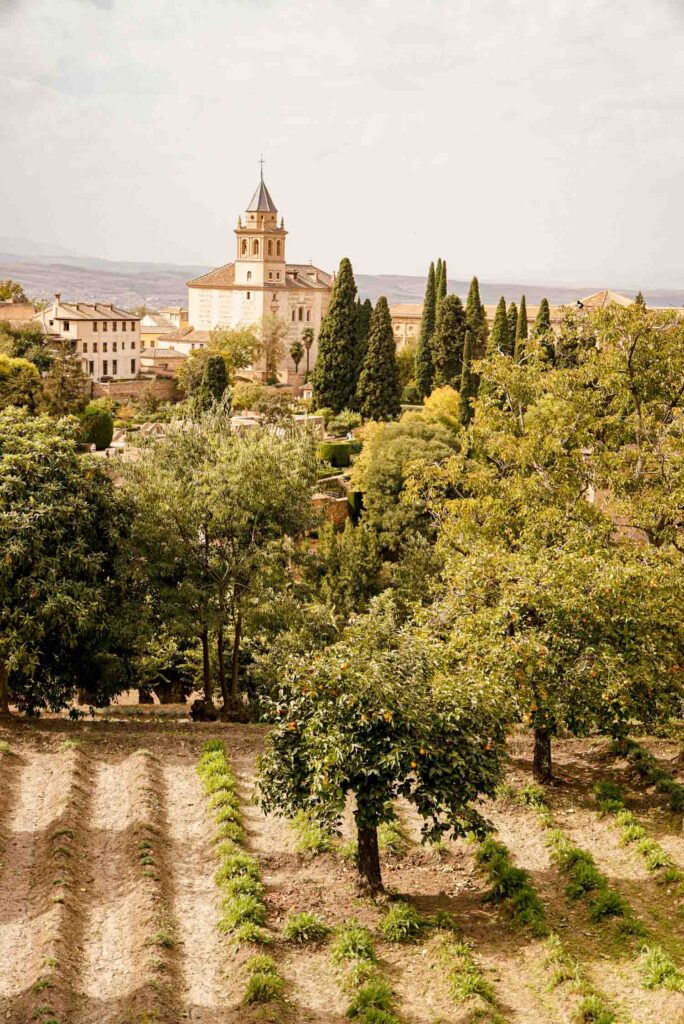

Allow at least 3 hours for your visit
Yes, I know you’re trying to see Granada in 2 days and have limited time, but trust me – you don’t want to rush your visit to the Alhambra! There is so much to see and so much interesting history here, and you want to take it all in. Spending 3 hours here is the bare minimum for your visit!
Our tour lasted 3 hours for just the Alcazaba, Generalife, and gardens, and I still spent a little bit of extra time here taking in the beauty of it all. If you’re planning to visit the Nasrid Palaces, I’d say allow at least 4 hours.
You’ll also want to factor in extra time to actually get to the complex, as it takes about 20-30 minutes from the historic center to get up to the Alhambra. It is hilly, but it’s a beautiful walk!
Bring your passport!
When booking your tickets or a tour, you will have to provide your passport information. Be sure to bring your passport on the day of your Alhambra visit, as you will need it to enter the grounds and as you enter various parts of the complex.

Sacromonte
After your time exploring the Alhambra, it’s time for the next stop of your Granada 2 day itinerary – Sacromonte.
Sacromonte is one of the most unique areas of Granada, traditionally the Roma (or gypsy – although that term is considered offensive) neighborhood. The Roma was forced to settle here, when they were not permitted to settle in the city itself.
This area is known for its cave dwellings, which are partially or completely dug into the sides of the cliffs here. Just walking down the main street here (Camino del Sacromonte), you can see the dwellings are built right into the hillsides – it’s an interesting sight!
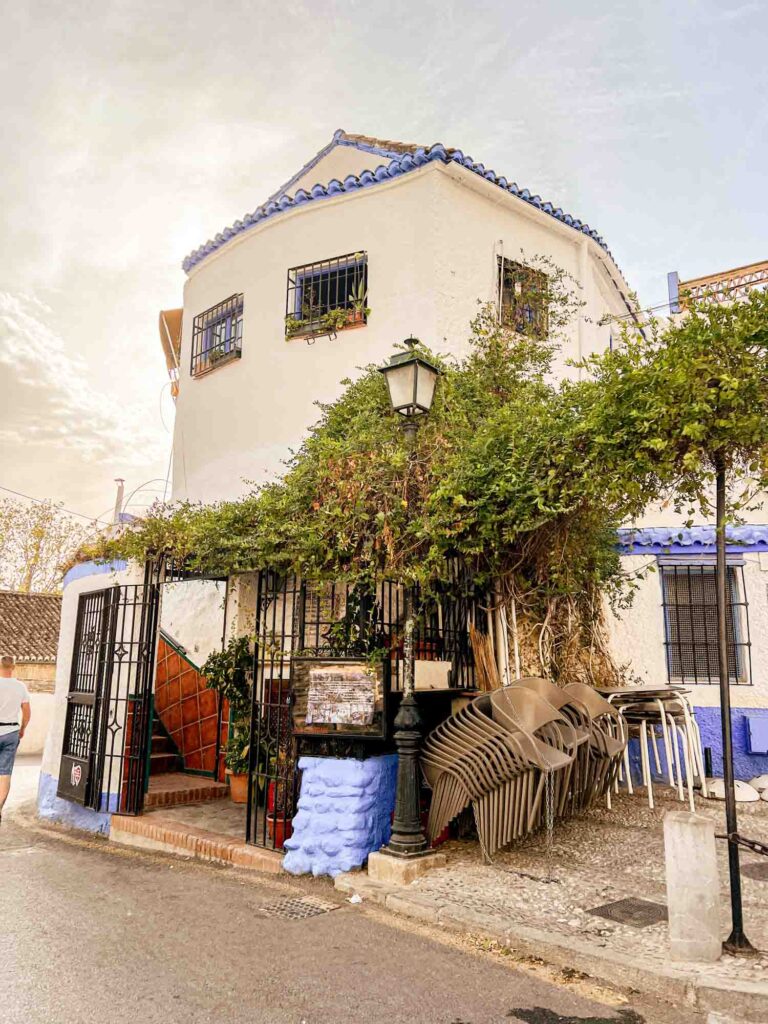

While most people in Sacromonte live in regular houses today, there are still some people who live in cave homes high up in the hills, without running water or electricity.
Some of the dwellings have been converted into tapas restaurants, shops, or flamenco theaters. Flamenco has its origins in the Roma tradition, and watching a flamenco show is one of the most popular things to do in Sacromonte. As we had already seen a flamenco show in Seville, we didn’t see one here, but watching a show in a cave theater would be a cool experience!


Museo Cuevas de Sacromonte
If you want to learn more about the cave dwellings of Sacromonte, this small museum is an ideal place to do so. The Museo Cuevas de Sacromonte is dedicated to the neighborhood’s cave dwellings and the people who once occupied them.
You’ll find recreated examples of the dwellings to show how people lived and worked in them. I especially enjoyed the one dedicated to flamenco, and how it played a role in the traditions of Sacromonte!

Go on a tapas crawl
You’ve made it to the end of this 2 day Granada itinerary and it’s time to tapear!
Did you know that you can get a free tapa when ordering a drink in one of the city’s many tapas restaurants? Yes, you heard that right – 100% gratis!
This is true in most of the city’s tapas bars, although there are a handful of them that don’t offer them. It is a tradition that is unique to the city, and one of the biggest reasons you should spend 2 days in Granada!



You don’t necessarily have to order an alcoholic drink – you’ll still get a free tapa when ordering bottled water or a soft drink. Usually, you won’t get a choice in what they bring you, but there are a few spots that let you choose from a menu. You’ll get a new tapa when you order another drink, and it will usually be something different.
It’s a fun (and cheap) way to eat dinner – I had so much fun hopping around to all the different tapas bars around the city and sampling what they had at each!
You can do a guided tapas tour to take you around to the best spots in the city – or you can create your own DIY tapas crawl!
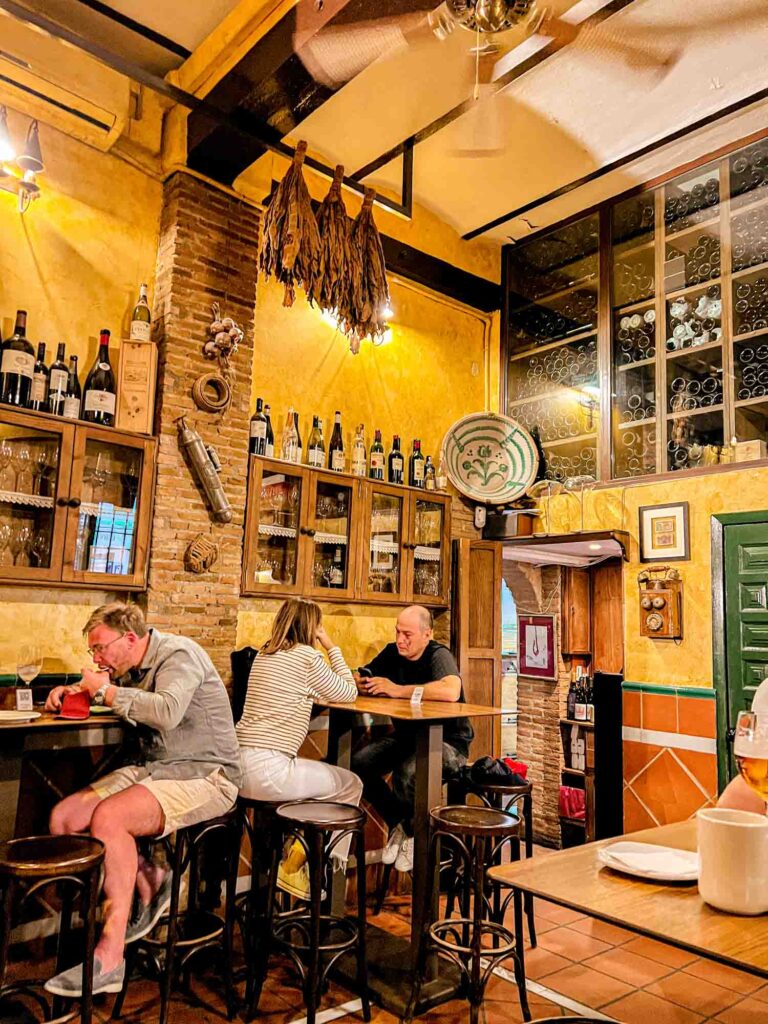


Here are some recommended tapas bars in the city:
- Los Manueles: One of the most popular tapas bars in the city. They are also famous for their croquettes here, so I suggest ordering one in addition to the free tapas you get!
- Bar La Riviera: This is one of the few spots where you can choose your free tapa from a menu of selections.
- Los Diamantes: They are known for their seafood tapas here!
- Taberna la Tana: This place was made famous after Anthony Bourdain paid a visit here. They have a really awesome wine list here, and some unique tapas you might not see elsewhere.
- Bodegas Castañeda: One of the storied tapas bars of Granada, dating back to 1927.
Have you ever been to Granada? How would you see Granada in 2 days?
More Spain content you may also enjoy:
10 Days in Barcelona + Andalusia: The Perfect Itinerary
The Perfect 2 Days in Seville Itinerary
How to See Barcelona in 3 Days
Most Instagrammable Places in Barcelona
Liked this post? Save this 2 days in Granada itinerary to Pinterest for later!


Caroline is a Southern California based traveler, writer, and photographer. She travels all around California, the US, and the world in search of the most colorful places, the most delicious food, and bucket-list adventures. Her aim is to inspire other travelers discover how to add more adventure and joy to their lives. On Pictures & Words, you’ll find detailed guides + itineraries, along with vibrant photos to help you plan the the most epic trips. When she’s not traveling, Caroline also runs half marathons.
